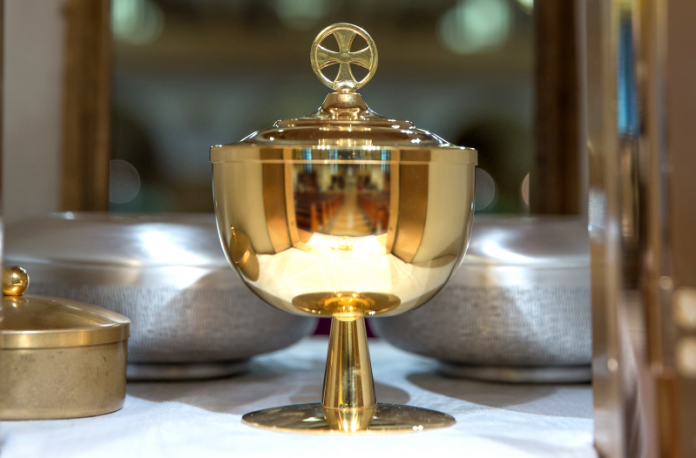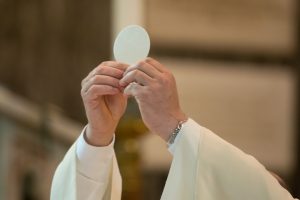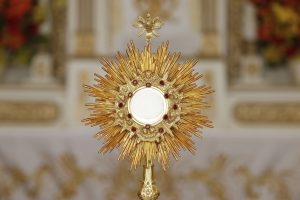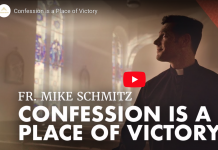
Five ways to teach the Eucharist
WILLIAM O’LEARY
Since the age of five, she longed to receive Jesus in Holy Communion. Her love for Christ in the Eucharist was so strong that she often wondered: “Can anyone receive Jesus into their heart and not die?” At the age of nine, she was granted permission to enter the Dominican Sisters at the convent in Bologna as a student and postulant. She constantly begged to be able to receive Jesus in Holy Communion earlier than the average age, but she was considered too young for her request to be granted. However, God’s providence made itself known following a Mass when she was praying. Suddenly, a bright light shown above her: It was Jesus in the Sacred Host. The priest realized that it was the Lord’s desire for her to receive Jesus. Her name is Blessed Imelda Lambertini, and she is the Patroness of First Communicants.
Another person who had a great love for Jesus in Holy Communion was a young boy in Roman times named Tarsicius. Willing to risk his life at a time when Christianity was illegal, he volunteered to take Jesus to the prisoners across town. On his way, he came across fellow peers who wanted him to play with them, but he said he could not. One of them noticed something underneath his cloak and asked him about it. Tarsicius didn’t answer and said he had to leave. But his peers refused to allow him to go until he told them what was under his cloak. Tarsicius continued to refuse and was bullied — beaten, and ultimately, stoned to death. The Eucharist was so precious to him he would rather die than allow it to be desecrated. St. Tarsicius was 14 years old.
These are just two examples of young people who loved Our Lord present in the Holy Eucharist. (The list could go on: See the lives of St. Thérèse, Little Li, St. Gemma Galgani, and Little Nelli of Holy God — the Chinese girl whose life inspired Venerable Fulton Sheen to more fully love the Eucharist and commit to a daily Holy Hour.)
Five approaches for catechesis on the Eucharist
We long for our young people information to encounter Jesus in the most wonderful way — Holy Communion. How can we help spark a desire to love and follow Jesus more fully? Here are five considerations when teaching the Eucharist.
1. Visit Jesus present in the tabernacle. Nothing is more concrete and impactful. As you take young people to visit Jesus, consider these points:
■ Share that they are not only going to visit the God of the universe who loves them, but he is going to visit them — in their hearts.
■ Stress the importance of genuflecting before Jesus Christ out of reverence for who he is.
■ Share with them that even though God is everywhere, he is present most fully on earth in every tabernacle throughout the world.
 2. Connect your lessons to the Mass. You might have two lessons during the year that are explicitly about the Eucharist and the Mass, but you should attempt to always connect each lesson with the Mass. Here are three possible examples.
2. Connect your lessons to the Mass. You might have two lessons during the year that are explicitly about the Eucharist and the Mass, but you should attempt to always connect each lesson with the Mass. Here are three possible examples.
■ When you are talking about God the Father (a lesson on creation or a lesson on the Our Father) be sure to talk about how everything the priest prays is directed at God our Father. Encourage your students to listen and hear this at Mass and to make the priest’s prayer their own prayer. Recall that all creation reflects God — and that at Mass the Scriptures often speak about the wonders of God’s creation. During the Offertory, the bread and wine brought forward represent the fruits of our labors to be offered up to God. This is a time to unite our lives with God the Father’s — to place our gifts on the altar (our joys, concerns, sufferings, needs, and blessings).
■ If you are teaching on the four marks of the Church (one, holy, catholic, and apostolic), each of these connect with Mass.
◗ The Church is one; all who receive Communion do so as a sign of our unity of belief in the Catholic Church and all we profess.
◗ The Church is holy, and God is calling us to be holy. He gives us himself in the Eucharist that we may receive the grace to live a Christian life. The Church is catholic (universal), and we are one family — united throughout the world wherever Mass is celebrated.
◗ The Church is apostolic because it was the Apostles who were given the authority by Jesus to continue his ministry. The Apostles and their successors have been given the power and authority to dispense the sacraments and forgive sins. The Mass makes present the reality of the Last Supper each time it is celebrated, and this is only possible because of the priesthood that comes from the apostolic nature of the Church. Additionally, Jesus commanded his Apostles at the Last Supper to “do this in memory of me” (Luke 22:19).
■ For a lesson on making good (moral) decisions, we can point to the Eucharist as being that source of grace that helps us make good decisions, do what is right according to God’s ways, and have the strength to imitate Jesus. Every lesson, if possible, should have a liturgical connection and point to the Mass.
3. Use the signs and symbols of the Mass to catechize. “The liturgy is the … privileged place for catechizing the People of God” (CCC, 1074). Teach by using the gestures and signs that happen during the liturgy of the Eucharist. Here are a few examples:
■ The Epiclesis: This is the holy moment when the Holy Spirit is called to come down and rest on the gifts of bread and wine to become the Body and Blood of Jesus Christ.
■ The Orans position: This is the gesture of the priest stretching out his arms at many moments during the Liturgy of the Eucharist, symbolizing that he is praying to the Father on our behalf, and his gesture indicates a receptive posture to receive God’s grace.
■ The corporal, purificator, paten, chalice, pall, and Roman Missal are items that you can show the young people that point to something beyond the visible. Although it may not be possible to actually have them present for the young people to see and touch, a picture would suffice.
■ Share how important the priesthood is to the Eucharist. Jesus becomes present on the altar and then present in us because of the priest. Without priests, the bread and wine could not be consecrated and become the Body and Blood of Christ.
■ The USCCB website has a description of the Eucharistic Prayer and the Communion Rite. Also, here is a link to the Order of the Mass. This can be a valuable way to share with young people what happens during the Liturgy of the Eucharist.
4. Share your love for the Eucharist and Holy Mass. Our students watch to see if what we say about things rings true in our lives.
■ Why is the Eucharist important in your life? How has the Eucharist affected your relationship with Jesus and your love for him? Share it!
■ Do your students see your joy for the faith and the Eucharist? Do your students see your reverence in the way you speak of Christ in the Eucharist or your example while at Mass?
Live it! The Catechism lists the fruits of Holy Communion in paragraphs 1391–1401. Catechists lives should confirm and testify to these fruits.
 5. Spend time with Jesus yourself. A life that is overflowing with a love for God is an Invaluable witness.
5. Spend time with Jesus yourself. A life that is overflowing with a love for God is an Invaluable witness.
Have you ever reflected on your role as a catechist and a person who is giving witness both in word and in deed to the wonder, beauty, and joy of the Catholic Faith? It is one of the greatest gifts you can give your students?
Fr. Jean-Baptiste Chautard wrote in the Soul of the Apostolate:
Is there anyone who does not know St. Bernard’s saying: “If you are wise, you will be reservoirs and not channels.” The channels let the water flow away, and do not retain a drop. But the reservoir is first filled, and then, without emptying itself, pours out its overflow, which is ever renewed, over the fields which it waters. How many there are devoted to works, who are never anything but channels, and retain nothing for themselves, but remain dry while trying to pass on life-giving grace to souls! “We have many channels in the Church today,” St. Bernard added, sadly, “but very few reservoirs.” (pp. 52-53)
The more we as catechists take this approach of being reservoirs and not channels, the better we will serve our students. The more we tap into the source of life — the Eucharist — the more our lives will be a radiant witness of Christ’s life. Let us be reservoirs and not get so caught up in our daily existence that we forget where our center needs to be — on and in Christ.
The Eucharist is a tremendous gift and is the source and summit of our faith. May we always teach and approach it with wonder and joy!
William O’Leary lives in Kansas with his wife and three children. He is the Director of Religious Formation for a large parish in Overland Park, Kansas. Over the last 20 years, he has been working in pastoral ministry and continues to explore ways to draw parents and their children into the practice of their faith. Read more about his work at RelevantCatechesis.com.
This article was originally published in Catechist magazine, November/December 2019
PHOTO: FAABI/ISTOCK




